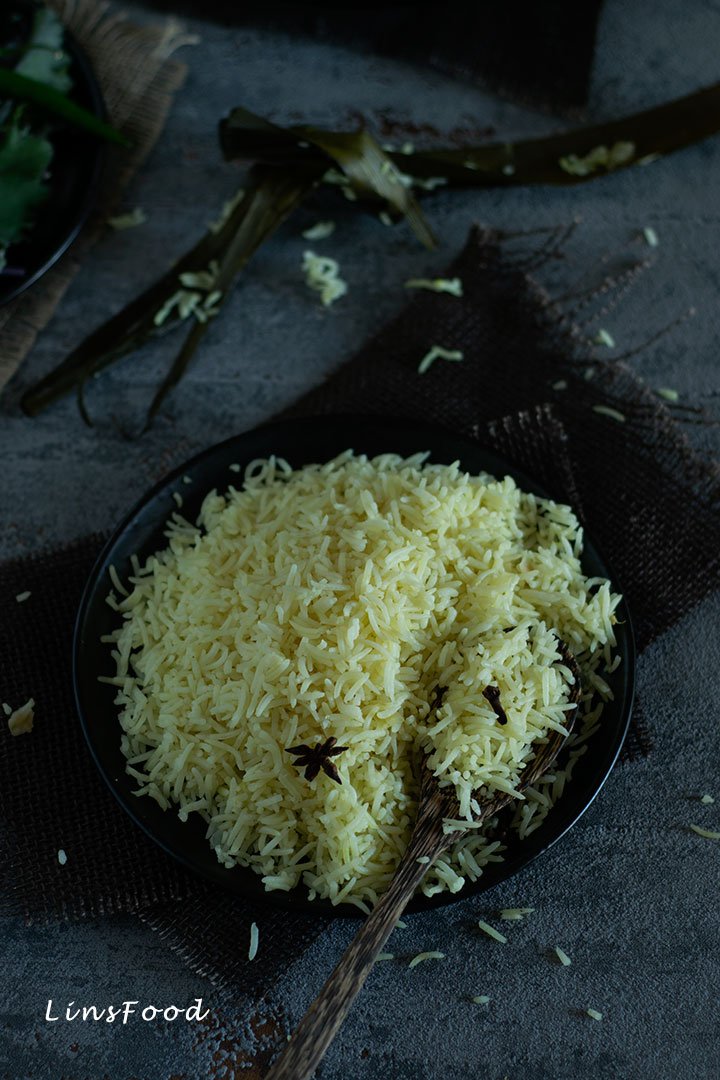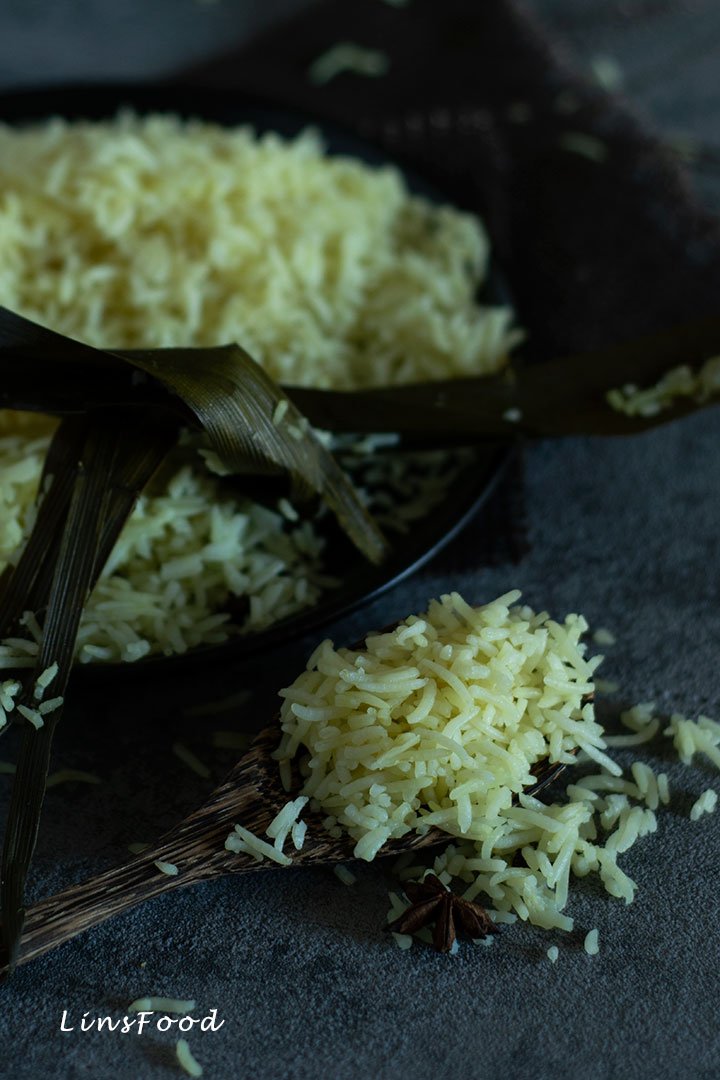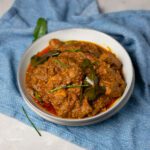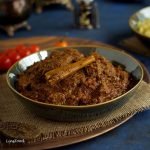Nasi Minyak is a Malay dish of fragrant, yellow rice cooked with a little ghee, evaporated milk, spices and pandan leaves.
Estimated reading time: 5 minutes

Nasi Minyak Recipe
When teaching and cooking, I’ve always described Nasi Minyak as the Malay equivalent of the Indian/Pakistani pilau rice. This seems to do the trick, my students and clients know exactly what to expect.
The fundamental difference between the two is the lack of cumin seeds, and the use of pandan leaves and evaporated milk.
Let’s look at the name first. In Malay and Indonesian,
- Nasi = rice
- Minyak = oil
- Sapi = cow
- Lembu = also cow
- Minyak Sapi = ghee
Here, the “oil” used is usually ghee (minyak sapi), which probably gives rise to some food sites and articles mistakenly translating it as ghee rice. Even if it is kind of technically correct, the ghee is just one of the ingredients in the recipe.
But let me tell you right now, don’t ever call it ghee rice, because the locals won’t really know what you’re talking about, and worse still, we may laugh at you!
In the old days (sounding more and more like my father-in-law), nasi minyak was cooked with just vegetable oil, and, I distinctly recall this from my childhood, margarine. Not ghee.
As a child in the 70s, I remember margarine being all the rage, eaten with just about anything. And cooked and baked with. There was a specific brand, Planta, that was like the gold standard when we were kids. I loved it then, but really can’t stand the stuff now!
There are many Malay families, especially in Malaysia, who still use margarine or vegetable oil when making their nasi minyak. Sometimes, along with ghee, sometimes, on its own.
So using ghee in Nasi Minyak was a gradual adaptation, a natural influence from the not insignificant Indian and Pakistani population in Singapore and Malaysia.
But that doesn’t mean nasi minyak is ghee rice!
A little Fun
Because you know I love sharing this sort of stuff with you!
“Lembu punya susu, sapi dapat nama”
An old Malay proverb that literally translated means “the cow’s milk but the (other) cow gets the name”.
In other words, a person getting the credit for work done by someone else.
There is a lot of speculation and various explanations about the word sapi and how it plays in the above proverb and the name Minyak Sapi for ghee.
Suffice it to say, sapi is an old Malay and Indonesian word for cow. The explanation could be as simple as the fact that ghee is fat derived from cows (via milk, then butter) hence minyak sapi.
Why not minyak lembu? Ah, that’s a discussion for another day perhaps. On a really, really long, rainy, boring day.
What is Ghee?
Ghee, an indispensable ingredient in Pakistani and northern Indian kitchens, is Clarified Butter, which is pure butter fat. It is obtained by cooking off all the milk proteins and water in butter, resulting in the most aromatic and flavoursome of fats.
Ghee is an ingredient that should be very easily available, no matter which part of the world you live in. As long as there’s a south Asian population (Indian/Pakistani), you’ll find it.
If you can’t, you’ll be pleased to know that ghee is easily made at home, in no more than 30 minutes. I have a recipe for a spiced version on LinsFood, Niter Kibbeh, which is Ethiopian Clarified butter, if you fancy flexing your culinary muscles. Just leave out the spices to make regular ghee.

How to Cook Nasi Minyak
It’s a pretty straightforward recipe, and I make it exactly the way I remember my granny, mum and aunt doing. They finish the rice off with a drizzle of evaporated milk, and so, I do the same.
This is what we do:
- Fry the dry spices
- Add the aromatics (onion, garlic, ginger)
- Add the rice
- Then the water, herb (pandan, see below) and half the evaporated milk and cook away
- Finish off with evaporated milk
Cooking Nasi Minyak in a Rice Cooker
If your rice cooker pot can go on the stove, then follow the recipe below, doing steps 1, 2 and 3 of Cooking the Rice.
Continue with step 4 in the rice cooker itself. So add the water and milk, and just leave it to cook.
If your rice cooker pot cannot go on the hob, then do steps 1, 2 and 3 in a frying pan, then transfer everything over to the rice cooker to finish the recipe from step 4.
Or the cheat’s version: dump everything in the rice cooker and hit the “ON” button!
How to Serve Nasi Minyak
Serve it with any Malay, Indonesian or even south Asian curries.



Pandan Leaves in Nasi Minyak
Click here to read more on LinsFood. Pandan, a type of screwpine, is an essential ingredient in South East Asian and South Asian cooking. And the Caribbeans too, apparently. With its sweet, fragrant, grassy aroma, it is widely used in both savoury and sweet dishes.
If you can’t get pandan leaves, just leave them out. Your rice is still going to be amazing.
However, you could, if you wanted to, drop in a couple of bay leaves (fresh or dried) just for some added aroma. Or even kaffir lime leaves, if you have access to those. I have both plants (pandan and kaffir lime), so am rather fortunate.
Here in the UK, fresh lime leaves are available in our larger supermarkets, like Ocado and Waitrose.
Time to get cooking!

Nasi Minyak Recipe (Malay Pilau Rice)
Equipment
- large saucepan or rice cooker
Ingredients
- 400 g basmati rice
- 2 Tbsp ghee
- 2 pandan leaves
- 680 ml water
- 70 ml evaporated milk semi skimmed will work too
- 1 tsp salt
- ⅛ tsp ground turmeric
Aromatics
- 1 medium onion brown
- 2 medium cloves garlic
- 2.5 cm ginger
Dry Spices
- 1 small cinnamon stick
- 1 star anise
- 3 cloves
- 2 cardamom pods
Instructions
Prep Work
- Rinse the rice, drain and set aside.
- Halve the onion, then and slice thinly. Chop up the garlic finely. Either chop the ginger up finely too, or grate it. If using pandan leaves, tie them up with a knot in the middle, set aside.
Let's Cook the Nasi Minyak
- Heat the ghee on medium heat and fry the dry spices for 30 seconds. So that's the cinnamon, star anise, cloves and cardamom.
- Add the onion and fry for a minute, then add the garlic and ginger and fry for another minute.
- Tip in the rinsed and drained rice, along with the turmeric. Stir well to toast the rice and to allow it to take on that delicious, aromatic fat.
- Drop in the pandan leaves, if using. Pour in the water, half the evaporated milk and add salt. Bring everything to a boil on medium-high heat. Leave the rice to cook at this heat, uncovered, until the water has been absorbed, and you start to see little holes appearing on the surface of the rice. Then, cover the saucepan, and reduce the heat to the lowest setting. Cook for 12 minutes.
- At the 12 minute mark, the rice should be cooked. Take it off the heat and let the rice rest (without taking the lid off) for 5 minutes on a cool surface. A cool hob will do.
- After 5 minutes, drizzle the rest of the evaporated milk and fluff up the rice. Lose the pandan leaves before serving. You could fish out the spices if you want to, but I don't bother.

Hello Lin,
thank you for showing / teaching us, Malaysians residing abroad, how to cook those wonderful Malaysian dishes and for the detailed explanations. I have mastered the Teh Tarik which I miss so much and which I can now enjoy everyday, thanks to you, Lin 🙂
I now plan on making this delicious sounding Nasi Minyak. When do I add the ground turmeric ?
Can you share an Acar recipe next. Thanks Lin.
Hi Shanti, it’s my absolute pleasure! I cannot live without my teh tarik, and more often than not, it’s teh tarik halia.
I left out the turmeric in the instructions, didn’t I? Have edited the recipe. I like to add the turmeric along with the rice.
Let me know how it goes. If you’re on Instagram, post a pic and tag me!
Nasi Minyak sounds delicious with the aromatic and herbs specially pandan leaves. Such a versatile recipe is useful on any occasion. Definitely will give it a try
Thank you, it certainly is.
Cooking rice with evaporated milk is such an interesting idea to explore! Can’t wait till I try this very aromatic recipe! Once again taking away a lot more from your blog than just a recipe. Thank you for clearing the Malaysian/Malay confusion for me.
Thank you, glad you enjoyed it. And you’ll have to try the evaporated milk!
Nasi Minyak looks so flavoursome with pandan leaves and eveaporated milk in it. Lovely dish, hope I get the pandan leaves soon.
Thank you, Jaya.
It’s dinner time right now and somehow the leftovers do not sound as delicious as before I read this recipe! I definitely want some nasi minyak malay pilau rice now. Will hunt for the pandan leaves too and hey thanks for the detailed explanation of all the names, ingredients too. I will now not ask for ghee rice 😀
A pleasure, you can use kewra in place of pandan.
Azlin I loved the rice recipe but I seriously liked your description it is so informative and interesting . Thanks for sharing this
Thank you, glad you think so!
A combination of South and South East Asian flavors. Nasi Minyak looks so tempting. I can imagine the combined aroma of ghee and pandan leaves. Cooking it with evaporated milk..amazing.
It really is so delicious!
Thank you for such a wonderful description. I love rice and this dish will go on my list of dishes to prepare.
Thank you.